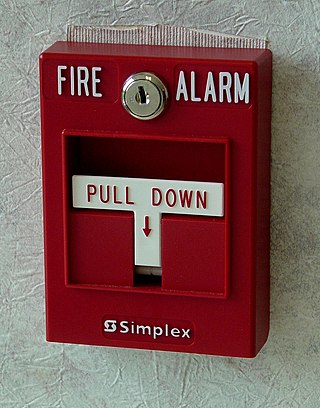Related Research Articles

An alarm device is a mechanism that gives an audible, visual, combination, or other kind of alarm signal to alert someone to a problem or condition that requires urgent attention.

The UL enterprise is a global safety science company headquartered in Northbrook, Illinois, composed of three organizations, UL Research Institutes, UL Standards & Engagement and UL Solutions.

A smoke detector is a device that senses smoke, typically as an indicator of fire. Smoke detectors/Alarms are usually housed in plastic enclosures, typically shaped like a disk about 150 millimetres (6 in) in diameter and 25 millimetres (1 in) thick, but shape and size vary. Smoke can be detected either optically (photoelectric) or by physical process (ionization). Detectors may use one or both sensing methods. Sensitive alarms can be used to detect and deter smoking in banned areas. Smoke detectors in large commercial and industrial buildings are usually connected to a central fire alarm system.

A fire alarm notification appliance is an active fire protection component of a fire alarm system. A notification appliance may use audible, visible, or other stimuli to alert the occupants of a fire or other emergency condition requiring action. Audible appliances have been in use longer than any other method of notification. Initially, all appliances were either electromechanical horns or electric bells, which would later be replaced by electronic sounders. Most of today's appliances produce sound levels between 70 and 100 decibels at three feet.

The National Electrical Code (NEC), or NFPA 70, is a regionally adoptable standard for the safe installation of electrical wiring and equipment in the United States. It is part of the National Fire Code series published by the National Fire Protection Association (NFPA), a private trade association. Despite the use of the term "national," it is not a federal law. It is typically adopted by states and municipalities in an effort to standardize their enforcement of safe electrical practices. In some cases, the NEC is amended, altered and may even be rejected in lieu of regional regulations as voted on by local governing bodies.

Fire safety is the set of practices intended to reduce destruction caused by fire. Fire safety measures include those that are intended to prevent the ignition of an uncontrolled fire and those that are used to limit the spread and impact of a fire.

A security alarm is a system designed to detect intrusions, such as unauthorized entry, into a building or other areas, such as a home or school. Security alarms protect against burglary (theft) or property damage, as well as against intruders. Examples include personal systems, neighborhood security alerts, car alarms, and prison alarms.

An emergency light is a battery-backed lighting device that switches on automatically when a building experiences a power outage.
The publication Life Safety Code, known as NFPA 101, is a consensus standard widely adopted in the United States. It is administered, trademarked, copyrighted, and published by the National Fire Protection Association and, like many NFPA documents, is systematically revised on a three-year cycle.

A fire alarm control panel (FACP), fire alarm control unit (FACU), fire indicator panel (FIP), or simply fire alarm panel is the controlling component of a fire alarm system. The panel receives information from devices designed to detect and report fires, monitors their operational integrity, and provides for automatic control of equipment, and transmission of information necessary to prepare the facility for fire based on a predetermined sequence. The panel may also supply electrical energy to operate any associated initiating device, notification appliance, control, transmitter, or relay. There are four basic types of panels: coded panels, conventional panels, addressable panels, and multiplex systems.
SimplexGrinnell, a subsidiary of Johnson Controls, is an American company specializing in active fire protection systems, communication systems and testing, inspection and maintenance services. The company headquarters is in Boca Raton, Florida; corporate sales and marketing offices are in Westminster, Massachusetts, and the company has about 160 district offices throughout North America. It is currently the largest fire protection company in the world.

Manual fire alarm activation is the process of triggering a fire alarm through a call point, pull station, or other device. This usually causes the alarm to sound the evacuation signal for the relevant building or zone. Manual fire alarm activation requires human intervention, as distinct from automatic fire alarm activation such as that provided through the use of heat detectors and smoke detectors. It is, however, possible for call points/pull stations to be used in conjunction with automatic detection as part of the overall fire detection and alarm system. Systems in completed buildings tend to be wired in and include a control panel. Wireless activators are common during construction.
NFPA 70E(Standard for Electrical Safety in the Workplace) is a standard of the National Fire Protection Association (NFPA). The document covers electrical safety requirements for employees. The NFPA is best known for publishing the National Electrical Code.

A carbon monoxide detector or CO detector is a device that detects the presence of the carbon monoxide (CO) gas to prevent carbon monoxide poisoning. In the late 1990s Underwriters Laboratories changed the definition of a single station CO detector with a sound device to carbon monoxide (CO) alarm. This applies to all CO safety alarms that meet UL 2034 standard; however for passive indicators and system devices that meet UL 2075, UL refers to these as carbon monoxide detectors. Most CO detectors use a sensor with a defined, limited lifespan, and will not work indefinitely.

A fire alarm system is a building system designed to detect, alert occupants, and alert emergency forces of the presence of fire, smoke, carbon monoxide, or other fire-related emergencies. Fire alarm systems are required in most commercial buildings. They may include smoke detectors, heat detectors, and manual fire alarm activation devices. All components of a fire alarm system are connected to a fire alarm control panel. Fire alarm control panels are usually found in an electrical or panel room. Fire alarm systems generally use visual and audio signalization to warn the occupants of the building. Some fire alarm systems may also disable elevators, which are unsafe to use during a fire under most circumstances.
A managed facilities-based voice network (MFVN) is a communications network managed, operated, and maintained by a voice service provider that delivers traditional telephone service via a loop start analog telephone interface. MFVNs are interconnected with the public switched telephone network (PSTN) or other MFVNs and provide dialtone to end users. Historically, this was provided by equipment at Bell company central offices, however today's MFVNs can include a combination of access network, battery-backed customer premises equipment (CPE), network switches and routers, network management systems, voice call servers, and gateways to the broader PSTN.
Faraday is a Florham Park, New Jersey company that specializes in fire protection systems.
Smoke dampers are passive fire protection products used in air conditioning and ventilation ductwork or installed in physical smoke barriers.
BS 5839 Part 1Fire detection and fire alarm systems for buildings – Part 1: Code of practice for design, installation, commissioning and maintenance of systems in non-domestic premises is a standard published by the British Standards Institution. BS 5839-1:2013 supersedes BS 5839-1:2002+A2:2008, which has been withdrawn. It s the first of 9 parts in a series on national standards relating to fire alarms.
Standards for alarm systems, installation and monitoring, are standards critical for ensuring safety, reliability, and interoperability. Various standards organizations, both international and regional, develop these guidelines and best practices. Globally recognized bodies such as ISO and IEC provide comprehensive frameworks applicable worldwide, while regional standards may cater to specific local requirements, enhancing the applicability and effectiveness of alarm systems in different environments.
References
- ↑ "NFPA 72: National Fire Alarm and Signaling Code". National Fire Protection Agency. Retrieved July 23, 2019.